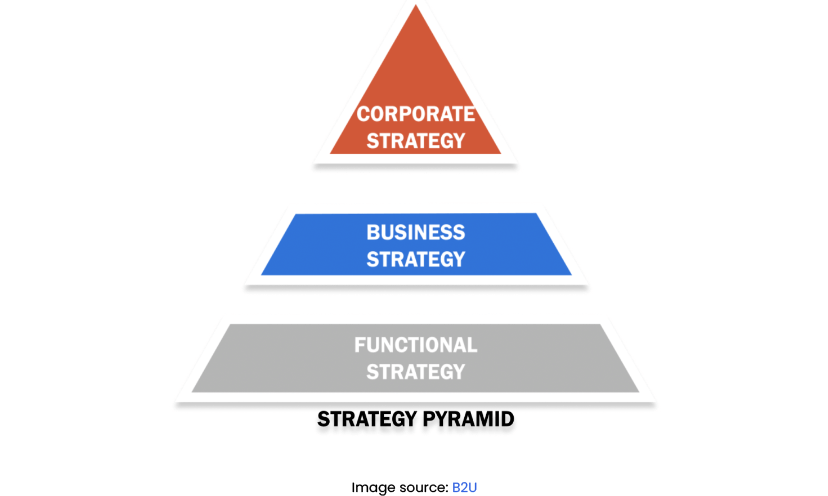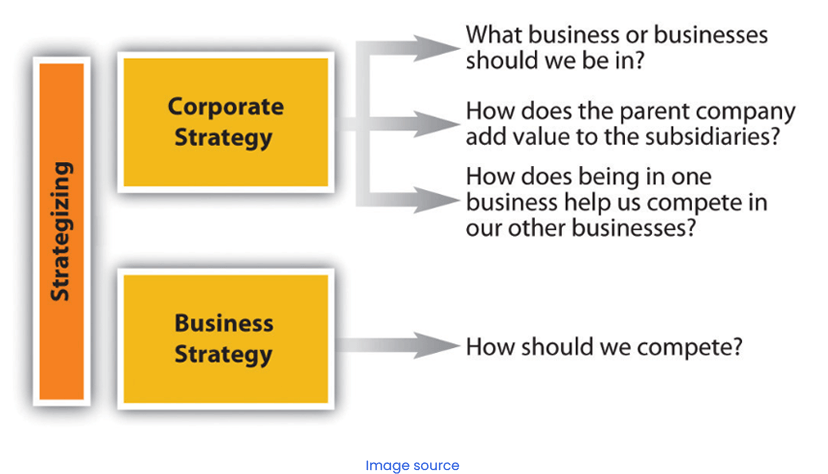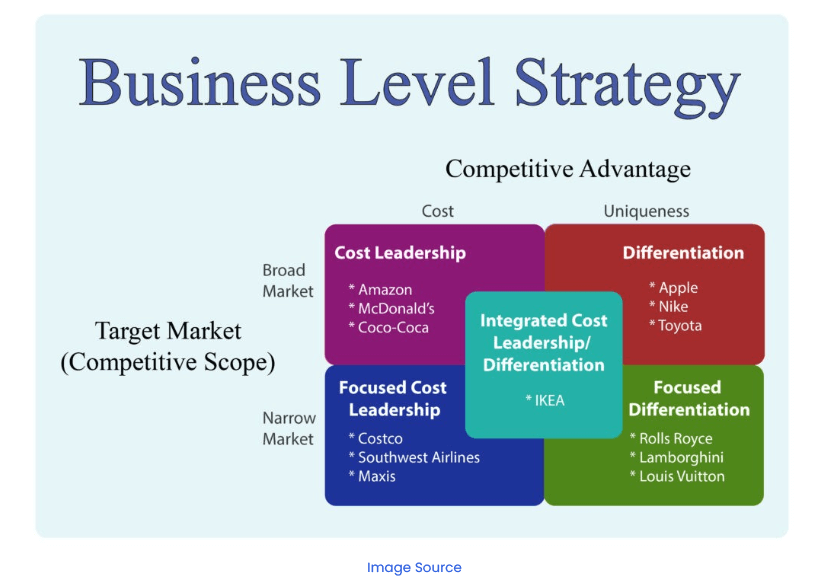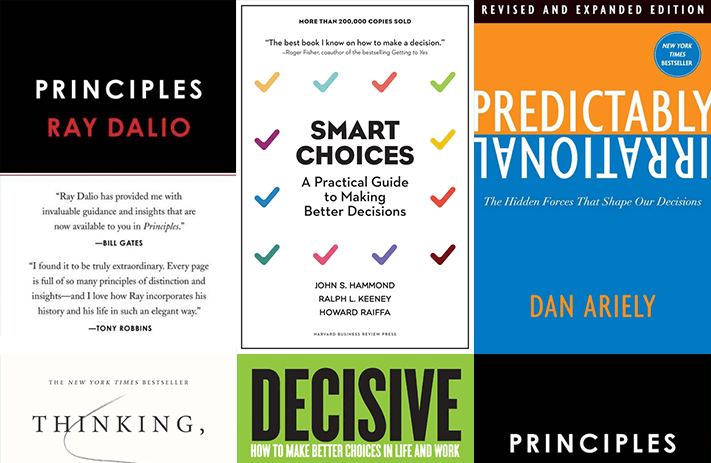
Click the button to start reading
No Results? Learn from Top Business-Level Strategy Examples to Secure Success
Have you ever wondered what makes some businesses rock while others just flop?
Well, it all comes down to their business-level strategies. Successful businesses use these strategies to beat the competition, adapt to changes, and rock the market like pros.
In this blog post, we’ll dive deep into business-level strategy examples. As we move on, we’ll see how businesses use them in an actual market environment. Plus, you’ll learn how to build your own strategy and get advanced tips to increase your productivity.
So buckle up! We’re about to reveal the secrets of strategic success.
Understanding the Complete Business Strategy: The Pyramid of the Three Core Levels

Managers who can’t see the big picture find it hard to know where their business is going.
But those who see the big picture have a smart way of thinking. They plan for the long run and consider the entire environment when making choices. This helps them handle changes and boost the company’s efficiency.
So before we proceed, we should first understand the complete business strategy.
Here’s what it involves. It starts with discovering the higher-level vision. Then, it zooms in on specific business choices. And finally, it focuses on efficient operations and functioning.
Now, let’s look at these three important levels one by one.
Corporate-Level Strategy
To put it simply, corporate strategy is all about where a company is headed and what it’ll do. It’s the big decisions made by top-level managers. Here, they figure out which businesses the company will be involved in and how to use resources effectively.
Corporate strategy answers the fundamental question of “What should our company do?” In other words, it helps the company define its mission, vision, and long-term objectives.
Should the company have a mix of different businesses or stick to one core area? Should you acquire other businesses or team up with partners to get even better? These questions are answered at the corporate level.

Business-Level Strategy
As for the business-level strategy, it’s about picking your best plan to win a particular game.
Business strategy answers the question of “How will our business unit compete?” This means checking out the market, looking at what others are doing, and figuring out how to make your business stand out.
- This strategy figures out what makes the company unique and better than its competitors.
- Who are your target customers? The business-level strategy helps identify the group of customers you want to make happy.
- You then take care of market positioning. Basically, you decide how you want customers to see and feel about your products or services. Understanding your marketing environment is also included here.
Functional Strategy
Lastly, the functional strategy refers to how each department in the company does its work. Markedly, it supports the business-level strategy and helps to achieve your business goals.
Functional strategies are, in fact, more detailed and specific. They guide the day-to-day activities of each department. For example, marketing might focus on product promotion and customer engagement. Finance, on the other hand, might emphasize cost control and budget management.
Learn From the Best: Inspiring Business-Level Strategy Examples
Businesses have various ways to gain a competitive advantage. They understand that each approach has its own strengths and difficulties.
So, the choice of strategy depends on factors like the resources available, the market they operate in, and how they want their brand to be perceived. It’s like picking the best path that suits their goals and capabilities.
Here are the four main examples of business-level strategy:
- Cost leadership
- Differentiation
- Focused cost leadership
- Focused differentiation

Cost Leadership Strategy
With a cost leadership strategy, you want to be the champion of low prices. Focus on being super efficient and saving money at every step. This way, you can offer products or services at prices that beat your competitors.
Key Highlights:
- Save money and work productively.
- Have lots of customers because of the great prices.
- Aim for customers who care about prices.
- Always find better ways to do things and spend less.
Business-Level Strategy Examples: Cost Leadership Strategy
Walmart – Mastering the Art of Cost Leadership
You know Walmart, right? They’re great at this strategy. They buy things in bulk and manage their stuff really well. And that’s how they can give us a wide range of products at affordable prices.
Dropbox – Cloud Storage with Cost-Effective Solutions
When we need a file storage solution, Dropbox is the name that comes to our minds. They offer a cost leadership strategy by giving us a great deal on their storage plans. We can keep all our files safe and sound without breaking the bank.
Differentiation Strategy
In this strategy, it’s all about being special and unique. Create products or services that are one-of-a-kind and make your customers go, “Wow!” If people love what you offer, they’re willing to pay more for the awesome experience.
Key Highlights:
- Offer something special and unique.
- Create a brand people love.
- Aim for customers who want quality and something special.
- Keep coming up with new ideas and invest in research.
Business-Level Strategy Examples: Differentiation Strategy
Apple – Innovating like no other
Apple is the king of cool gadgets. They love to come up with cool and easy-to-use stuff. And they’re the experts in differentiation. From iPhones to Macs, their products have a distinct style and features that people adore. After all, Apple fans gladly pay a little extra for their exceptional stuff.
Salesforce – Making customers happy
Salesforce is all about helping businesses keep their customers super happy. Their CRM software is customized and comes with cool features. Moreover, the integration of salesforce flow within their CRM system streamlines complex workflows, offering a more dynamic and efficient customer management experience. It doesn’t matter if a company is big or small – Salesforce works for everyone. They use clever technology like AI to give businesses useful advice and insights. This helps businesses make better choices and provide awesome experiences to their customers. That’s why companies love using Salesforce to build strong relationships with their customers.
Focused Cost Leadership Strategy
Here, you become the low-cost hero in your niche. So, focus on a small, specialized group of customers and give them the best deal in town. You don’t need to be cheap for everyone, but within your niche, be the superhero of low prices.
Key Highlights:
- Focus on a specific group of customers.
- Know exactly what they want and need.
- Make personalized products or services for them.
- Become known as the experts in that niche.
Examples of Focused Cost Leadership Strategy
Ryanair – The Budget-Friendly Sky Soarers
Ever heard of Ryanair? They do this so well in the airline world! They target budget travelers in Europe and offer no-frills flights at super-low prices. People who want to save money while flying love Ryanair.
Zoom – Quality Communication, Affordable Solutions
Zoom is a fantastic example of a company that uses a focused cost leadership strategy. If you’re looking for high-quality services at competitive prices, Zoom is for you.
They provide video conferencing and collaboration solutions primarily targeting businesses and educational institutions. Besides, Zoom has a user-friendly platform and cost-effective plans. That’s why it has become a go-to choice for companies seeking affordable and reliable virtual communication tools.
Focused Differentiation Strategy
Pick a small group of customers and make them feel pecial with unique products or services. Stand out in that niche, and you’ll win their hearts and loyalty. That’s how you become the star in a special niche.
Key Highlights
- Target a specific group of customers.
- Offer them something unique and special.
- Stand out in that niche and shine bright.
Examples of Focused Differentiation Strategy
Tesla – Electrifying Innovation on Wheels
Tesla, the electric car genius! They’ve nailed this strategy in the automotive world. Tesla focuses on electric vehicles with cutting-edge technology and eco-friendly features. People who love electric cars and sustainability admire Tesla.
Canva – Design Magic Made Simple
They’re the design gurus for non-designers. With a focused differentiation strategy, Canva offers lots of ready-to-use templates. Thanks to its easy-peasy design, you can make beautiful designs in no time.
The Hybrid Approach
A hybrid approach to business-level strategy is when a company combines elements of more than one strategy. They mix and match these strategies or switch between them as they grow and change.
So, imagine being both the “budget hero” and the “cool stuff” master at the same time. Some companies do just that. They offer products or services at affordable prices, but they also add special features to impress their customers.

A Step-by-Step Guide: How to Build Your Business-Level Strategic Plan
After we’ve covered the examples of business-level strategy, it’s time to write an effective business-level strategic plan.
First, know this: a McKinsey survey showed that 70% of executives weren’t happy with how their company plans its strategies. Besides, an equal percentage of board members didn’t trust the outcomes of that planning process.
But don’t worry. Here is a roadmap to help you succeed.
Step 1: Conduct a SWOT Analysis.
Start by analyzing your company’s strengths, weaknesses, opportunities, and threats. In other words, perform a SWOT analysis. Understand what you do well and where you might have limitations. Plus, find out the potential growth areas and the challenges your business may face. This analysis forms the foundation for your strategy.
Step 2: Define Your Target Market.
Identify your target customers and market segment. Understand their needs, preferences, and pain points. Tailor your strategy to cater to these specific customer groups. Finally, ensure your offerings resonate with them.
Step 3: Set Clear Goals.
Next, establish specific, measurable, achievable, relevant, and time-bound (SMART) goals for your business. Your objectives should align with your company’s mission and vision. Only this way they’ll serve as a guiding force for your strategy.
Step 4: Choose Your Business-Level Strategy.
Based on your SWOT analysis and target market, decide on the appropriate business-level strategy. Will you focus on cost leadership, offering low prices to attract customers? Or will you differentiate your products or services to stand out from competitors? Select the strategy that aligns best with your goals.
Step 5: Develop Action Plans.
As you move on, translate your business-level strategy into actionable plans. Outline the specific steps, initiatives, and resources needed to put your strategy into action. Assign responsibilities to team members and set timelines for each action.
Step 6: Get the Stuff You Need.
Make sure you have everything you need to do your plan, like money, people, and technology. Without these, your plan won’t work. Use what you have smartly to make your plan happen.
Step 7: Check Your Progress and Change if Needed.
Keep an eye on how well you’re doing towards your goals. Be ready to learn and change your plan based on feedback and what’s happening in the market. Stay flexible and adjust to what’s going on around you.
Step 8: Talk and Work Together.
Tell everyone in your company about your plan. Make sure they all understand where the company is going and what we want to achieve. Get your team to work together with the same focus and direction.
Step 9: Look Back and Learn.
Finally, look back and see how well your plan worked. Look at the good things and the challenges you faced. Learn from your experiences and use this knowledge to make your plan even better next time. If in need, grab the best books to fine-tune your business strategy.
Now you’re all set to write a business-level strategic plan that sets your company on the path to success. Remember, each step builds upon the other, creating a powerful roadmap for your business’s journey.

Boost Your Strategy: 5 Advanced Tips for Building Success
Creating a business-level strategy requires thoughtful analysis and strategic thinking. Here are some advanced tips to help you craft a powerful and effective business-level strategy:
1. Deep Customer Insights
First, gain a deep understanding of your target customers’ needs, preferences, and pain points. If you want to know the trends and patterns, conduct full market research and collect customer feedback. The more you know about your customers, the better you can adjust your strategy to meet their needs.
2. Be a Step Ahead of the Competition
Do a complete check of your competitors to see what they’re good at and where they might be lacking. Learn about how they do things, where they stand in the market, and what makes them unique. This will help you find ways to stand out and find new opportunities that others might have missed.
3. Focus on What You’re Awesome At
As a next step, figure out what your company is really good at – the things you do exceptionally well. Make a plan that uses and improves these strengths to stand out and have an edge over others. Stick to what makes your company special and valuable in the market. Despite market shifts, this will help you stay strong and competitive in the long run.
4. Everyone’s In This Together
Get everyone involved in making the strategy, from top bosses to employees and outside partners. Their different ideas and skills can make the strategy better, and when everyone helps create it, they’ll be more committed to making it work.
5. Supercharge Your Strategy with the Right Tools
Wanna create a winning business strategy? Project management tools can help by keeping everything organized and help you see the big picture. Take, for example, Teamly. It’ll let you plan, collaborate, and track progress with ease. Imagine having all your team members on the same page and working together smoothly. With Teamly, you can easily align your strategy with sales, marketing, finance and everything in between. So, wave that magic wand and watch your strategy come to life, achieving the success your team deserves.
Conclusion
Learning about business-level strategy examples is like having a superpower. It makes you a better leader and a valuable resource for your company’s success. How? Quite simply! You learn how to find great opportunities and lead your team towards big goals.
Plus, when you know about business-level strategies, you become more flexible and ready for changes. In the face of challenges, you know how to adjust your plans quickly. And there you are – the smart and adaptable leader everyone is looking up to for guidance.
















